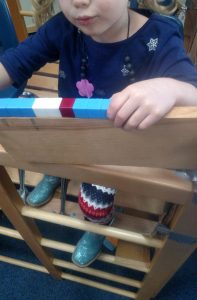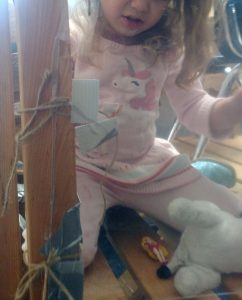Hi again! As promised, here’s a quick and dirty description of what the children have been doing, what they plan to do, and what I’ve observed them learning. There’s also a useful link at the bottom.
In the previous posts, I didn’t describe these additional activities in which the children engaged:
- Measured their feet to figure out how big to make the pedals
- Measured a piece of wood to match (picture below)
- The door cracked — they fixed it.
- Pretended to go on a flight
- Felt the sensation of wearing a real pilot’s headset
- Continued learning how to read maps
- Began learning about scale and its relationship to the phenomenon that things look smaller when they are farther away

Every pilot needs a flight bag containing vital equipment and information.
With two weeks to go before break, the students plan to:
- Install port side wing strut
- Make and install instrument panel
- Paint the Piper logo (link is not an endorsement, just a reference!) on the first control yoke and install
- Build, paint, and install second yoke
- Possibly add the pedals and rudder

The kneeboard…

…holds the flight map securely to the pilot’s leg.

The pilot can’t drop it and never needs to hold it in their hands.
From an educator’s perspective, the students have been using and building a variety of skills and abilities:
- book research
- guided internet research
- working with a subject matter expert (Mrs. Linstromberg)
- using uniform, non-standard tools to take linear measurements for authentic purposes
- solving problems using math
- using divergent and convergent thinking to solve problems
- writing (students made labels for various parts of their plane)
- conducting physics experiments (cars on the wing)
- iterative design:
- evaluating the effectiveness of a strategy or technique
- imagining and/or learning of new techniques to try
- trying them
- re-evaluating, re-imagining, re-trying…
- reading diagrams of airplane parts
- expanding fine motor skills through cutting and pasting a collage of aircraft
- expanding gross motor skills through finding new ways to get in and out of the climber with the new door and with no slide attached

A white light in the cockpit would dangerously affect the pilot’s vision. A red light is used to illuminate anything the pilot needs to see inside.
Perhaps most important, I believe the students have been building the following dispositions:
- the belief that they are autonomous beings whose contributions are valuable to themselves and to others
- curiosity
- as they see me learning from Mrs. Linstromberg, I believe they are seeing that learning is a lifelong, enjoyable endeavor
- cooperation
- creativity and inventiveness
- problems are for solving and they have the capacity to solve them
- persistence

measuring the wood we’ll use to make the pedals

Later, I found this. A student had measured it all the way around…just for fun.
There are several sets of new photos to be enjoyed on the Otter Class Protected Images Page. Click, enter your password, and enjoy!!




































